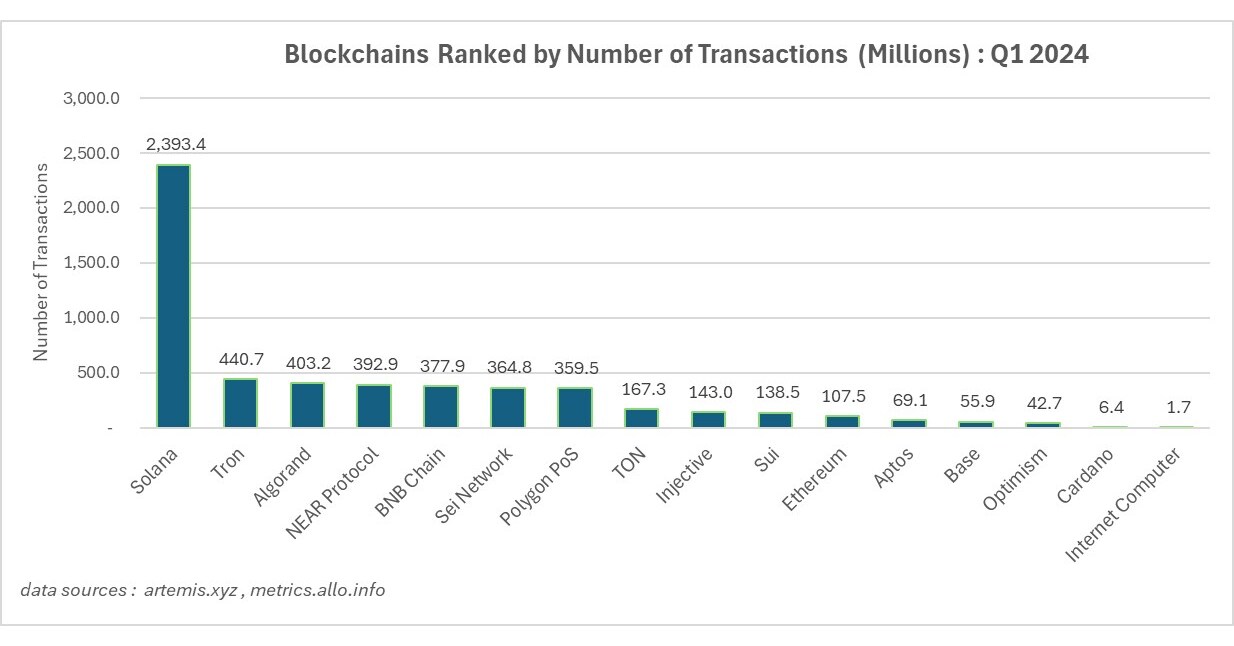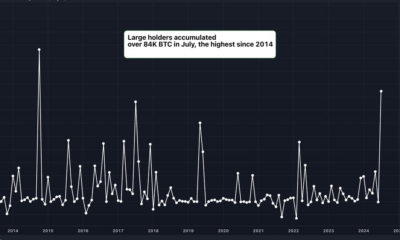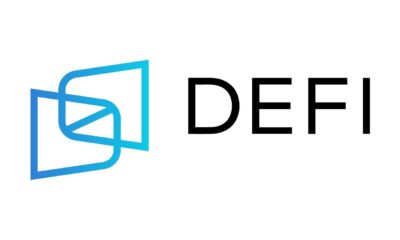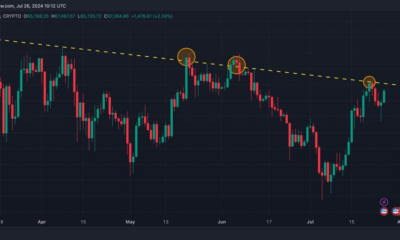DeFi
Algorand Celebrates 5th Anniversary with 2 Billion Transactions and Record Adoption of Real Use Cases at Annual Decipher Conference

Foundation Kicks Off Algorand Summer with Investments in Technology, Partnerships and Marketing to Fuel Innovation at Scale
BARCELONA, Spain, June 28, 2024 /PRNewswire/ — The Algorand Foundation, a nonprofit organization whose mission is to create a world where information has integrity and innovative ideas can scale, hosted its annual Decipher event, a gathering of hundreds of investors, developers, and partners from around the world to celebrate this vibrant ecosystem. From global finance and supply chain to real estate and humanitarian aid, Algorand’s blockchain technology is powering the next generation of real-world applications. Showcasing the refreshed brand, the new website at Algorand.co is the nerve center of our protocol and our ecosystem.
Algorand is the #3 blockchain ranked by number of transactions in Q1 2024.
“The energy at Decipher is contagious! We are in awe of the creativity and technical prowess of our community and all the innovative products they have built on Algorand,” said Staci Warden, CEO of the Algorand Foundation. “They are bringing blockchain to life, and we encourage them to channel that enthusiasm into building and scaling their dreams. And we promise to continue investing in the resources they need to succeed.”
Algorand is an energy-efficient, quantum-secure, single-layer blockchain with instant finality, consistently high throughput, and low fees. All of these features mean it’s purpose-built for real-world scaling; and developers, entrepreneurs, and enterprise partners all benefit from its institutional-grade certainty and resilience.
Ecosystem dynamics
The Algorand blockchain has reached two billion successful transactions since its inception in June 2019. In the first quarter of 2024 alone, it ranked among the top 3 most popular blockchains in terms of transaction volume.
Other notable statistics:
- On January 1, 2024, Algorand reached an ATH of 43 million transactions in a single day, and the network performed flawlessly. [1]
- On May 17, 2024, it reached a record high of 5,716 transactions per second (TPS), ranking among the top 3 blockchains in terms of maximum recorded TPS. [2]
- In the first quarter, the Algorand blockchain processed 403 million transactions, an increase of 288% compared to the fourth quarter of 2023.
- In the first quarter, Algorand gained 1 million new accounts, bringing the total to 35 million, with an average of 800,000 monthly active users. [1]
- Algorand concluded Q1 2024 with a DeFi TVL of 1 billion ALGO and maintained this level in the following months. [3]
To improve access to real-time data and information on the Algorand blockchain, the Foundation is partnering with data analytics provider Nansenand expects the first dashboards to go live this summer.
Data Source References
[1] https://metrics.allo.info/
[2] https://chainspect.app/dashboard
[3] https://defillama.com/chain/Algorand?currency=ALGO
The following main initiatives were announced at the event:
- Global fintech and web3 companies including Algorand Foundation, UNDP, Worldpay, Circle, HesabPay, Mercy Corps Enterprises and others are joining forces to scale up blockchain-based financial aid for humanitarian crises.
- Archax creates abrdn money market fund accessible and transferable on the Algorand blockchain using Quantoz EURD electronic money token.
- 123carbon has been awarded a contract for 135,000 t of CO2e, one of the largest transport-related insert emissions in the world, all recorded on the Algorand blockchain.
- LabTrace completed the first study using its blockchain-based data authentication system, designed to ensure data integrity in clinical trials.
- Finboot moved to Algorand to power its supply chain traceability solution with the scalability and energy efficiency of Algorand.
- Kare Survivor Wallet will provide rapid financial assistance to disaster survivors across the United States as part of the American Response and Resilience Program, launched with National VOAD and DSC, SVDP-USA.
- Circle USDCa Algorand’s stablecoin is now available via Coinbase.
Ecosystem companies are thriving, from AI and identity to DeFi and NFTs:
- Pear And Immersion announced a partnership to bring non-custodial debit card options to Algorand users.
- Popular Finances announced the upcoming launch of xChain, an application that will leverage the cross-chain staking products and xALGO Liquid, which allow users to participate in Algorand consensus and accumulate rewards in a transparent and secure manner.
- Algorand now also houses Helpless, a blockchain-based AI marketplace that makes the exchange of AI services, products and data more transparent.
- CompX announced a new advancement in RWA by integrating with Lofty to bring the benefits of auto-composition and yield optimization to more users on the chain.
- Little manthe leading DEX on Algorand in terms of TVL, volume and active users, has announced that its TINY token and governance platform will launch in July.
- Messina launched Token Wars and the creation of a cross-chain community, increasing the exposure and presence of Algorand DeFi. This initiative is supported by Pact, Mixing the goldAnd CompX.
- Vestige Laboratories launches rug.ninja, a decentralized token creator and virtual DEX for the fair creation and exchange of meme coins.
- Mixing the gold announced a world-first Trust-Minimized Audit System that verifiably connects physical items to the blockchain, the final frontier for bringing physical RWAs trustlessly on-chain.
- Gora And Goanna have teamed up to create a pioneering nftFi project on Algorand, a collection with innovative utility for Gora and Algorand users. The website and project are live, with the launch event scheduled for July.
- EXA Market is launching a rewards program on Coinlist in August, ahead of its token launch in Q4.
- The Cosmic Champions will be launched on Mainnet and Google Play in August. Created over 2 years ago, their goal is to integrate thousands of Web2 users into Algorand.
- Recently listed on Steam, Fractals will also be listed on the Epic Game Store to onboard thousands of new users to Algorand Gaming.
- Aegir Tactics will enter closed beta on July 23 with a website update, gameplay video, and Founders Vaults (NFT card packs). Currently available on the Epic Game Store, Aegir Tactics can be wishlisted.
- Dead Chain Diaries joins Algorand’s NFT collection, as the first-ever listing set, featuring creators from across the #Algofam.
- Rxelms is a new cross-chain NFT-based virtual world launching this year on Algorand, using the best-in-class Unity game engine.
- NUVO launched on Algorand and specialized in decentralized verifiable credentials to better protect data privacy.
Public goods
The Foundation’s Public Goods initiative focuses on DeFi and tools that help builders of all sizes realize their dreams in the most efficient way possible.
Challenge
Algorand’s instant finality, high TPS capacity, and speed are essential for the high-frequency trading required by DeFi. With a rapidly growing TVL and strong Foundation support, Algorand is leading the way as a robust and scalable DeFi platform.
The Foundation uses the Algorand DeFi ecosystem to manage its own treasury. It has deployed 42 million ALGO across various protocols to support things like AlgoRai, decentralized options vaults, and Tinyman and Pact’s liquid governance DEX trading. Following the positive results and feedback, the Foundation will redouble its efforts and increase liquidity to grow the DeFi ecosystem.
New development tools:
- LiquidAuth, an open source package to demonstrate how to establish authenticated P2P communication between wallets and applications using only open standards and non-permissive protocols.
- did:something, W3C-compliant DID method leveraging Algorand’s boxed storage, a more robust digital identity offering for Algorand applications.
- Lora Visual Debuggera local developer explorer powered by the new Subscriber Library to track on-chain events and analyze on-chain resources. It completes the trio of AlgoKit components needed for easier development: an SDK/for building, a Python testing framework, and a visual interface to debug and understand what’s happening both in your smart contracts and on-chain.
About the Algorand Foundation
Algorand’s mission is to create a world where information has integrity and innovative ideas can thrive. The Algorand Foundation supports Algorand’s growing ecosystem by providing a world-class development environment, supporting key infrastructure and establishing technical standards, providing comprehensive support to builders and entrepreneurs, and providing the infrastructure needed for decentralized governance.
Founded by Turing Award-winning cryptographer Silvio Micali in 2019, Algorand has grown into a vibrant ecosystem of developers, entrepreneurs, and enterprise partners who benefit from institutional-grade certainty and resilience, while features like low fees, instant finality, and minimal carbon footprint also appeal to the protocol’s millions of retail users. Developers of all kinds can use common programming languages like Python to build advanced applications and protocols that solve important problems on a global scale: instant payments in war and disaster zones, self-sovereign identity for the underprivileged, supply chain traceability for global trade, permissionless protocols addressing financial inclusion, and creating entirely new markets through tokenization, to name a few. To learn more and start your Algorand journey, visit algorand.co
SOURCE Algorand Foundation
DeFi
Haust Network Partners with Gateway to Connect to AggLayer

Dubai, United Arab Emirates, August 1, 2024, Chainwire
Consumer adoption of cryptocurrencies is a snowball that is accelerating by the day. More and more people around the world are clamoring for access to DeFi. However, the user interface and user experience of cryptocurrencies still lag behind their fundamental utility, and users lack the simple and secure access they need to truly on-chain products.
Haust Network is a network and suite of products focused on changing this paradigm and bringing DeFi to the masses. To achieve this goal, Haust Network has announced its far-reaching partnership with bridgeseasoned veterans in rapidly delivering revolutionary blockchain utilities for projects. The Gateway team empowers blockchain developers to build DAOs, NFT platforms, payment services, and more. They drive adoption of crypto primitives for individuals and institutions around the world by helping everyone build their on-chain presence.
Gateway specializes in connecting sovereign blockchains to the Aggregation Layer (AggLayer). The AggLayer is a single unified contract that powers the Ethereum bridge of many disparate blockchains, allowing them all to connect to a single unified liquidity pool. The AggLayer abstracts away the complexities of cross-chain DeFi, making tedious multi-chain transactions as easy for the end user as a single click. It’s all about creating access to DeFi, and with Polygon’s technology and the help of Gateways, Haust is doing just that.
As part of their partnership, Gateway will build an advanced zkEVM blockchain for Haust Network, leveraging its extensive experience to deploy ultra-fast sovereign applications with unmatched security, and enabling Haust Network to deliver its products to its audience.
The recently announced launch of the Haust Wallet is a Telegram mini-app that provides users with access to DeFi directly through the Telegram interface. Users who deposit funds into the wallet will have access to all standard send/receive services and generate an automatic yield on their funds. The yield is generated by Haust Network’s interconnected network of smart contracts, Haustoria, which provides automated and passive DeFi yielding.
As part of this partnership, the Haust Network development team will work closely with Gateway developers to launch Haust Network. Gateway is an implementation provider for Polygon CDK and zkEVM technology, which the Haust wallet will leverage to deliver advanced DeFi tools directly to the wallet users’ fingertips. Haust’s partnership with Gateway comes shortly after the announcement of a high-profile alliance with the Polygon community. Together, the three will work to build Haust Network and connect its products to the AggLayer.
About Haust Network
Haust Network is an application-based absolute liquidity network and will be built to be compatible with the Ethereum Virtual Machine (EVM). Haust aims to provide native yield to all users’ assets. In Telegram’s Haust Wallet, users can spend and collect their cryptocurrencies in one easy place, at the same time. Haust operates its network of self-balancing smart contracts that interact across multiple blockchains and then efficiently funnel what has been generated to Haust users.
About Gateway
bridge is a leading white-label blockchain provider that offers no-code protocol deployment. Users can launch custom blockchains in just ten minutes. They are an implementation provider for Polygon CDK and have already helped projects like Wirex, Gnosis Pay, and PalmNFT bring new utility to the crypto landscape.
About Polygon Labs
Polygon Laboratories Polygon Labs is a software development company building and developing a network of aggregated blockchains via the AggLayer, secured by Ethereum. As a public infrastructure, the AggLayer will aggregate the user bases and liquidity of any connected chain, and leverage Ethereum as the settlement layer. Polygon Labs has also contributed to the core development of several widely adopted scaling protocols and tools for launching blockchains, including Polygon PoS, Polygon zkEVM, and Polygon Miden, which is currently under development, as well as the Polygon CDK.
Contact
Lana Kovalski
haustnetwork@gmail.com
DeFi
Ethena downplays danger of letting traders use USDe to back risky bets – DL News

- Ethena and ByBit will allow derivatives traders to use USDe as collateral.
- There is a risk in letting traders use an asset partially backed by derivatives to place more bets.
Ethena has downplayed the dangers of a new feature, which will allow traders to put up its synthetic dollar USDe as collateral when trading derivatives, which are risky bets on the prices of crypto assets.
While allowing users to underwrite their trades with yield-bearing USDe is an attractive prospect, Ethena said there is potential risk in letting traders use an asset partially backed by derivatives to place even more derivatives bets.
“We have taken this risk into account and that is why Ethena operates across more than five different sites,” said Conor Ryder, head of research at Ethena Labs. DL News.
The move comes as competition in the stablecoin sector intensifies.
In recent weeks, PayPal grown up the amount of its stablecoin PYUSD in circulation 96%, while the MakerDAO cooperative plans a rebrandingaiming to increase the supply of its DAI stablecoin to 100 billion.
US dollar growth stagnates
It comes as Ethena has lost momentum after its blockbuster launch in December.
In early July, USDe reached a record level of 3.6 billion in circulation.
That figure has now fallen by 11% to around 3.2 billion.
Join the community to receive our latest stories and updates
New uses for USDe could boost demand for Ethena’s products.
This is where the new plan, announcement Tuesday with ByBit, one of its partner exchanges, is coming.
Ethena users create USDe by depositing Bitcoin or Ether into the protocol.
Ethena then covers these deposits with short positions – bearish bets – on the corresponding asset.
This creates a stable support for USDe, unaffected by price fluctuations in Bitcoin or Ether.
Mitigate risks
While using USDe as collateral for derivatives trading is proving popular, it is unclear what the effects will be if the cryptocurrency market experiences major fluctuations.
Using derivatives as collateral to place more bets has already had disastrous effects.
In June 2022, Lido’s liquid staking token stETH broke its peg to Ether following the fallout from the Terra collapse.
Many traders who used looping leverage to increase their stETH staking yields were liquidated, creating a cascade that caused the price of Ether to drop by more than 43%.
Ethena Labs founder Guy Young said: DL News His office and his partners have taken many precautions.
Ethena spreads bearish bets supporting the USDe across the five exchanges it partners with.
According to Ethena, 48% of short positions supporting USDe are on Binance, 23% on ByBit, 20% on OKX, 5% on Deribit, and 1% on Bitget. website.
In doing so, Ethena aims to minimize the impact of an unforeseen event on a stock market.
The same theory applies to the distribution of risks across different supporting assets.
Fifty percent of USDe is backed by Bitcoin, 30% by Ether, 11% by Ether liquid staking tokens, and 8% by Tether’s USDT stablecoin.
Previous reviews
Ethena has already been criticised regarding the risks associated with USDe.
Some have compared USDe to TerraUSD, an undercollateralized stablecoin that collapsed in 2022.
“It’s not a good design for long-term stability,” said Austin Campbell, an assistant professor at Columbia Business School. said as the USDe launch approaches.
Young replied to critics, saying the industry needs to be more diligent and careful when “marketing products to users who might not understand them as well as we do.”
Ethena has since added a disclaimer on its website stating that USDe is not the same as a fiat stablecoin like USDC or USDT.
“This means that the risks involved are inherently different,” the project says on its website.
Tim Craig is DL News DeFi correspondent based in Edinburgh. Feel free to share your tips with us at tim@dlnews.com.
DeFi
Cryptocurrency and defi firms lost $266 million to hackers in July

In July 2024, the cryptocurrency industry suffered a series of devastating attacks, resulting in losses amounting to approximately $266 million.
Blockchain Research Firm Peck Shield revealed in an X post On August 1, attacks on decentralized protocols in July reached $266 million, a 51% increase from $176 million reported in June.
The most significant breach last month involved WazirX, one of India’s largest cryptocurrency exchanges, which lost $230 million in what appears to be a highly sophisticated attack by North Korean hackers. The attack was a major blow to the stock market, leading to a break in withdrawals. Subsequently, WazirX launched a program in order to recover the funds.
Another notable incident involved Compound Finance, a decentralized lending protocol, which suffered a governance attack by a group known as the “Golden Boys,” who passed a proposal who allocated 499,000 COMP tokens – valued at $24 million – to a vault under their control.
The cross-chain liquidity aggregation protocol LI.FI also fell victim On July 16, a hack resulted in losses of $9.73 million. Additionally, Bittensor, a decentralized machine learning network, was one of the first protocols to suffer an exploit last month, loming $8 million on July 3 due to an attack targeting its staking mechanism.
Meanwhile, Rho Markets, a lending protocol, suffered a $7.6 million breach. However, in an interesting twist, the exploiters research to return the stolen funds, claiming the incident was not a hack.
July 31, reports The Terra blockchain protocol was also hacked, resulting in a loss of $6.8 million across multiple cryptocurrencies. As crypto.news reported, the attack exploited a reentrancy vulnerability that had been identified a few months ago.
Dough Finance, a liquidity protocol, lost $1.8 million in Ethereum (ETH) and USD Coin (USDC) to a flash loan attack on July 12. Similarly, Minterest, a lending and borrowing protocol, saw a loss of $1.4 million due to exchange rate manipulation in one of its markets.
Decentralized staking platform MonoSwap also reported a loss of $1.3 million following an attack that allowed the perpetrators to withdraw the liquidity staked on the protocol. Finally, Delta Prime, another decentralized finance platform, suffered a $1 million breach, although $900,000 of the stolen funds was later recovered.
DeFi
The Rise of Bitcoin DeFi: Then and Now

The convergence of Bitcoin’s robust security and Layer 2 scaling solutions has catalyzed the emergence of a vibrant DeFi ecosystem.
By expanding Bitcoin’s utility beyond simple peer-to-peer payments, these advancements have opened up a new frontier of financial possibilities, allowing users to participate in decentralized lending, trading, and other complex smart contract operations on Bitcoin.
Read on to learn about the rise of Bitcoin-based decentralized finance and how the space has expanded to accommodate a new generation of native assets and features.
Note: If you want to learn candlesticks and chart trading from scratch, this is the best book available on Amazon! Get the book now!
What is DeFi?
Decentralized finance (DeFi) represents a paradigm shift in financial services, offering internet-based financial products such as trading, lending, and borrowing through the use of decentralized public blockchains.
By implementing blockchains, smart contracts, and digital assets, DeFi protocols provide financial services through a decentralized ecosystem, where participants do not have to deal with intermediaries when transacting.
What is Bitcoin DeFi?
The inherent limitations of the Bitcoin mainchain in supporting the intricacies of decentralized finance have created the need to develop smart contract-based Layer 2 solutions.
Additionally, the advent of the Ordinals protocol in 2023, which facilitated the emergence of fungible token standards such as BRC-20 and Runes, catalyzed the growth of DeFi on the Bitcoin blockchain.
This expansion in protocol diversity has broadened the applications of the world’s leading cryptocurrency network beyond the core base-layer use cases around value preservation and transactional capabilities.
Therefore, Bitcoin DeFi has become a nascent sector within the digital asset market, after previously being a missing essential part of the Bitcoin ecosystem.
Bitcoin DeFi in its early days
Integrating decentralized finance (DeFi) concepts into the Bitcoin ecosystem has been a journey of innovation and perseverance. Early attempts to bridge the gap between Bitcoin’s fundamental simplicity and DeFi’s complexities have spawned pioneering projects that, while laying essential foundations, have also encountered significant obstacles.
Colored coins
Colored coins represented an early foray into tokenizing real-world assets on the Bitcoin blockchain. By leveraging the existing network to track ownership of assets ranging from stocks to real estate, this approach highlighted Bitcoin’s potential as a platform beyond digital currency. However, scalability and practical implementation challenges have limited its widespread adoption.
Counterpart
Building on the colored coins, Counterparty has become a platform for creating and trading digital assets, including non-fungible tokens (NFTs), on Bitcoin.
The introduction of popular projects like Rare Pepe NFTs has demonstrated the growing appeal of digital collectibles. However, constraints around user experience and network efficiency have hampered its full potential.
These early experiments, while not fully realizing their ambitions, served as valuable stepping stones, informing Bitcoin DeFi’s subsequent developments. Their challenges highlighted the need for more sophisticated infrastructure and protocols to harness the full potential of decentralized finance on the Bitcoin network.
Bitcoin DeFi Today
Today, building DeFi applications on Bitcoin is primarily done in the realm of Layer 2 (L2) networks. This architectural choice is motivated by the limitations of Bitcoin’s base layer in supporting complex programmable smart contracts.
Bitcoin’s original design prioritized security and decentralization over programmability, making it difficult to develop sophisticated DeFi protocols directly on its blockchain. However, the recent emergence of protocols like Ordinals, BRC-20, and Runes, while not DeFi in their own right, has sparked possibilities for future DeFi-like applications on the main chain.
In contrast, L2 solutions offer a scalable and programmable environment built on Bitcoin, enabling the creation of various DeFi products.
By expanding Bitcoin’s capabilities without compromising its core principles, L2s have become the preferred platform for developers looking to build DeFi applications that encompass trading, lending, staking, and more.
Leading L2 networks such as Lightning Network, Rootstock, Stacks, and Build on Bitcoin provide the infrastructure for these efforts. Some of these L2s have even introduced their own native tokens to the network, further expanding Bitcoin’s DeFi ecosystem.
Essentially, while Bitcoin’s core layer presents challenges for DeFi development, its security and decentralization have provided a foundational layer for the innovative L2 landscape to thrive.
Bitcoin Layer 2 offers a promising path to building a robust and thriving Bitcoin-based DeFi ecosystem that offers trading, staking, lending, and borrowing. All you need is a DeFi Wallet like Xverse to access the new world of decentralized financial services secured by Bitcoin.
Conclusion
The integration of DeFi principles into the Bitcoin ecosystem, primarily facilitated by Layer 2 solutions, marks a significant evolution in the digital asset landscape.
Building on the foundational work of pioneers like Colored Coins and Counterparty, the industry has evolved into more sophisticated platforms like Rootstock, Stacks, and Build on Bitcoin to create a thriving Bitcoin-powered DeFi ecosystem.
Advertisement
-

 News12 months ago
News12 months agoBitcoin soars above $63,000 as money flows into new US investment products
-

 DeFi12 months ago
DeFi12 months agoEthena downplays danger of letting traders use USDe to back risky bets – DL News
-

 News12 months ago
News12 months agoFRA Strengthens Cryptocurrency Practice with New Director Thomas Hyun
-

 DeFi12 months ago
DeFi12 months agoZodialtd.com to revolutionize derivatives trading with WEB3 technology
-

 Markets12 months ago
Markets12 months agoBitcoin Fails to Recover from Dovish FOMC Meeting: Why?
-

 DeFi1 year ago
DeFi1 year ago👀 Lido prepares its response to the recovery boom
-

 Markets1 year ago
Markets1 year agoWhale Investments in Bitcoin Reached $100 Billion in 2024, Fueling Crazy Investor Optimism ⋆ ZyCrypto
-

 Markets1 year ago
Markets1 year agoWhy Bitcoin’s price of $100,000 could be closer than ever ⋆ ZyCrypto
-

 DeFi1 year ago
DeFi1 year agoPancakeSwap integrates Zyfi for transparent, gas-free DeFi
-

 Markets1 year ago
Markets1 year agoWhales are targeting these altcoins to make major gains during the bull market 🐋💸
-

 DeFi1 year ago
DeFi1 year ago🏴☠️ Pump.Fun operated by Insider Exploit
-

 News1 year ago
News1 year agoHow to make $1 million with crypto in just 1 year 💸📈

















